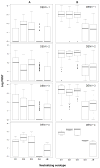Inferring the serotype associated with dengue virus infections on the basis of pre- and postinfection neutralizing antibody titers
- PMID: 20738205
- PMCID: PMC2943243
- DOI: 10.1086/656141
Inferring the serotype associated with dengue virus infections on the basis of pre- and postinfection neutralizing antibody titers
Abstract
Background: Currently, the only tests capable of determining the serotype associated with dengue virus (DENV) infection require sampling during the period of acute viremia. No test can accurately detect the serotype associated with past DENV infections. The standard assay for determination of serotype-specific antibody against DENV is the plaque reduction neutralization test (PRNT), although performance of this test continues to be evaluated.
Methods: From a cohort study among schoolchildren in Thailand, PRNT values were determined in serum samples collected before and after infection. A multinomial logistic regression model was used to infer the serotype associated with intercurrent DENV infections. Models were validated based on polymerase chain reaction identification of DENV serotypes.
Results: The serotype associated with DENV infection inferred by the model corresponded with polymerase chain reaction in 67.6% of cases, and the kappa statistic was 0.479. A model for 35 cases with primary seroconversion correctly identified the DENV serotypes causing infection in 77.1% of cases, compared with 66.9%, using a model for 169 cases with secondary seroconversion. The best model using only postinfection PRNT values correctly inferred the DENV serotype causing infection in 60.3% of cases.
Conclusions: A statistical model based on both pre- and postinfection PRNT values can be used to infer the serotype associated with DENV infections in prospective studies and vaccine trials.
Conflict of interest statement
The authors do not have any commercial or other associations that might pose a conflict of interest.
Figures


Similar articles
-
Dengue virus neutralizing antibody levels associated with protection from infection in thai cluster studies.PLoS Negl Trop Dis. 2014 Oct 16;8(10):e3230. doi: 10.1371/journal.pntd.0003230. eCollection 2014 Oct. PLoS Negl Trop Dis. 2014. PMID: 25329173 Free PMC article.
-
Simultaneous quantitation of neutralizing antibodies against all four dengue virus serotypes using optimized reporter virus particles.J Virol. 2024 Jul 23;98(7):e0068124. doi: 10.1128/jvi.00681-24. Epub 2024 Jul 2. J Virol. 2024. PMID: 38953379 Free PMC article.
-
Genotype-specific and cross-reactive neutralizing antibodies induced by dengue virus infection: detection of antibodies with different levels of neutralizing activities against homologous and heterologous genotypes of dengue virus type 2 in common marmosets (Callithrix jacchus).Virol J. 2018 Mar 27;15(1):51. doi: 10.1186/s12985-018-0967-x. Virol J. 2018. PMID: 29587780 Free PMC article.
-
Neutralization of Dengue Virus Serotypes by Sera from Dengue-Infected Individuals Is Preferentially Directed to Heterologous Serotypes and Not against the Autologous Serotype Present in Acute Infection.Viruses. 2021 Sep 29;13(10):1957. doi: 10.3390/v13101957. Viruses. 2021. PMID: 34696387 Free PMC article.
-
Spatial dimensions of dengue virus transmission across interepidemic and epidemic periods in Iquitos, Peru (1999-2003).PLoS Negl Trop Dis. 2012;6(2):e1472. doi: 10.1371/journal.pntd.0001472. Epub 2012 Feb 21. PLoS Negl Trop Dis. 2012. PMID: 22363822 Free PMC article.
Cited by
-
Dengue seroprevalence in the French West Indies: a prospective study in adult blood donors.Am J Trop Med Hyg. 2015 Jun;92(6):1137-1140. doi: 10.4269/ajtmh.14-0211. Epub 2015 Apr 6. Am J Trop Med Hyg. 2015. PMID: 25846291 Free PMC article.
-
Reduced risk of disease during postsecondary dengue virus infections.J Infect Dis. 2013 Sep;208(6):1026-33. doi: 10.1093/infdis/jit273. Epub 2013 Jun 17. J Infect Dis. 2013. PMID: 23776195 Free PMC article.
-
A review of dengue diagnostics and implications for surveillance and control.Trans R Soc Trop Med Hyg. 2019 Nov 1;113(11):653-660. doi: 10.1093/trstmh/trz068. Trans R Soc Trop Med Hyg. 2019. PMID: 31365115 Free PMC article. Review.
-
Dengue viruses cluster antigenically but not as discrete serotypes.Science. 2015 Sep 18;349(6254):1338-43. doi: 10.1126/science.aac5017. Science. 2015. PMID: 26383952 Free PMC article. Clinical Trial.
-
Using NS1 Flavivirus Protein Microarray to Infer Past Infecting Dengue Virus Serotype and Number of Past Dengue Virus Infections in Vietnamese Individuals.J Infect Dis. 2021 Jun 15;223(12):2053-2061. doi: 10.1093/infdis/jiaa018. J Infect Dis. 2021. PMID: 31967302 Free PMC article.
References
-
- Halstead SB. Dengue. Lancet. 2007;370:1644–52. - PubMed
-
- Whitehead SS, Blaney JE, Durbin AP, Murphy BR. Prospects for a dengue virus vaccine. Nat Rev Microbiol. 2007;5:518–28. - PubMed
-
- Kyle JL, Harris E. Global spread and persistence of dengue. Annu Rev Microbiol. 2008;62:71–92. - PubMed
-
- Pediatric Dengue Vaccine Institute. Global burden of Dengue. Vol. 2009. Seoul, Korea: 2009.
Publication types
MeSH terms
Substances
Grants and funding
LinkOut - more resources
Full Text Sources
Medical
Miscellaneous

